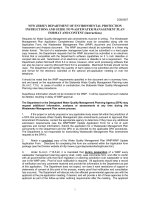Nanomedicine and cancer joseph abel department of physics, USU
Bạn đang xem bản rút gọn của tài liệu. Xem và tải ngay bản đầy đủ của tài liệu tại đây (307.4 KB, 19 trang )
Chapter 11
Esters, Amides
Chemistry 20Formation of Esters
RC O H
O
A carboxylic acid
=
Fischer Esterification
RCO R
'
O
RC-OH
O
H
-
O R
'
=
=
An alcohol
A carboxylic acid
An ester
H
2
SO
4
+ H
2
O
•
Name the alkyl group from the alcohol –OR.
•
Followed by name of the acid in which the suffix “-ic acid”
is replaced by suffix “-ate”.
acid alcohol
|| methyl
CH
3
—
C—O —CH
3
ethanoate IUPAC: methyl ethanoate
(acetate) common: methyl acetate
Naming of Esters
O
propyl
CH
3
—
C—O —CH
2
—CH
2
—CH
3
Propyl ethanoate (IUPAC)
Propyl acetate (common)
CH
3
—CH
2
—C—O—CH
2
—CH
3
Ethyl propanoate
Naming of Esters
O
O
Ethyl ethanoate
(Ethyl acetate)
Diethyl pentanedioate
(Diethyl glutarate)
CH
3
COCH
2
CH
3
O O
OO
O
O
A five-membered
lactone
O
Ethyl ethanoate
(Ethyl acetate)
Diethyl pentanedioate
(Diethyl glutarate)
CH
3
COCH
2
CH
3
O O
OO
O
O
A five-membered
lactone
O
Naming of Esters
Ethyl ethanoate
(Ethyl acetate)
Diethyl pentanedioate
(Diethyl glutarate)
CH
3
COCH
2
CH
3
O O
OO
O
O
A five-membered
lactone
O
Ethyl ethanoate
(Ethyl acetate)
Diethyl pentanedioate
(Diethyl glutarate)
CH
3
COCH
2
CH
3
O O
OO
O
O
A five-membered
lactone
O
Naming of Esters
Lactones: Cyclic esters
Ethyl ethanoate
(Ethyl acetate)
Diethyl pentanedioate
(Diethyl glutarate)
CH
3
COCH
2
CH
3
O O
OO
O
O
A five-membered
lactone
O
CH
3
—
C—OH + HO—CH
2
—CH
3
CH
3
—
C—O—CH
2
—CH
3
+
H
2
O
Fischer Esterification
H
2
SO
4
Ethanoic acid
(Acetic acid)
Ethanol
(Ethyl alcohol)
Ethyl ethanoate
(Ethyl acetate)
O
Esters give flowers and fruits their pleasant fragrances and
flavors.
Properties of Esters
Hydrolysis: reaction with water.
(breaking a bond and adding the elements of water)
RCO R '
O
RC-OH
O
H
-
O R
'
=
=
An alcohol
A carboxylic acid
An ester
+ H
2
O
+
Heat
Acid
Properties of Esters
Saponification (Hydrolysis): an ester reacts with a hot aqueous base.
RCO R
'
O
RCO-Na
O
H
- O R
'
=
=
An alcohol
A sodium salt
An ester
+ NaOH
+
H
2
O
Heat
-
+
CH
3
CO
CH
2
CH
3
O
CO-Na
O
CH
3
CH
2
OH
=
=
Ethanol
Sodium acetate
Ethyl Ethanoate
+ NaOH
+
-
+
CH
3
Properties of Esters
•
Esters react with ammonia and with 1° and 2° amines to form
amides.
Thus, an amide can be prepared from a carboxylic acid by first converting
the carboxylic acid to an ester by Fischer esterification and then reaction of
the ester with an amine.
OCH
2
CH
3
O
+
NH
3
NH
2
O
+
CH
3
CH
2
OH
Ethyl 2-phenyl acetate 2-Phenylacetamide
Amides
In an amide, the -OH group in the carboxyl group of a
carboxylic acid is replaced by an Amino group (-NH
2
).
CH
3
—
C—OH CH
3
—
C — NH
2
Amides
=
O
=
O
Formation of Amides
RC O H
O
A carboxylic acid
=
RCNH R
'
O
RC-OH
O
H
-
N HR
=
=
An Amine
A carboxylic acid
An amide
Heat
+ H
2
O
'
H
2
OCH
3
C-NHCH
2
CH
3
O
H HN CH
2
CH
3
CH
3
C-OH
O
+
+
Acetic acid
Ethanamine
N-ethylethanamide
Change the end of the name of the carboxylic acids from
“-oic acid” to “-amide”.
methanoic acid
H–C–NH
2
methanamide (IUPAC)
propanoic acid
CH
3
–CH
2
–C–NH
2
propanamide (IUPAC)
Naming of Amides
O
=
=
O
CH
3
–C–NH–CH
3
N-methylethanamide
CH
3
–CH
2
–C–N(CH
3
)
2
N,N-dimethylpropanamide
CH
3
–C–N(CH
2
CH
3
)
2
N,N-diethylethanamide
Naming of Amides
=
O
=
O
=
O
Lactams: Cyclic amides
Naming of Amides
O
NH
O
NH
A four-membered lactam
(a β-lactam)
A seven-membered lactam
α
β
Properties of Amides
Such as esters:
Hydrolysis in hot aqueous acid or base.
CH
3
CH
2
CH
2
CNH
2
O
H
2
O HCl
H
2
O
CH
3
CH
2
CH
2
COH
O
NH
4
+
Cl
-
Butanoic acid
Butanamide
++ +
heat
CH
3
CNH
O
NaOH
H
2
O
CH
3
CO
-
Na
+
O
H
2
N
AnilineSodium
acetate
Acetanilide
+
+
heat
Amides do not react with ammonia or with amines.
Properties of Amides









